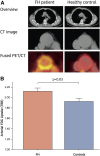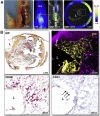Metabolic and Molecular Imaging of Atherosclerosis and Venous Thromboembolism
- PMID: 28450558
- PMCID: PMC5450364
- DOI: 10.2967/jnumed.116.182873
Metabolic and Molecular Imaging of Atherosclerosis and Venous Thromboembolism
Abstract
Metabolic and molecular imaging continues to advance our understanding of vascular disease pathophysiology. At present, 18F-FDG PET imaging is the most widely used clinical tool for metabolic and molecular imaging of atherosclerosis. However, novel nuclear tracers and intravascular optical near-infrared fluorescence imaging catheters are emerging to assess new biologic targets in vivo and in coronary arteries. This review highlights current metabolic and molecular imaging clinical and near-clinical applications within atherosclerosis and venous thromboembolism, and explores the potential for metabolic and molecular imaging to affect patient-level risk prediction and disease treatment.
Keywords: PET; atherosclerosis; molecular imaging; near infrared fluorescence; venous thromboembolism.
© 2017 by the Society of Nuclear Medicine and Molecular Imaging.
Figures




Similar articles
-
PET imaging of chemokine receptors in vascular injury-accelerated atherosclerosis.J Nucl Med. 2013 Jul;54(7):1135-41. doi: 10.2967/jnumed.112.114777. Epub 2013 May 8. J Nucl Med. 2013. PMID: 23658218 Free PMC article.
-
Molecular imaging of atherosclerosis with integrated PET imaging.J Nucl Cardiol. 2017 Jun;24(3):938-943. doi: 10.1007/s12350-016-0766-y. Epub 2017 Jan 11. J Nucl Cardiol. 2017. PMID: 28078575 Free PMC article. Review.
-
In Vivo ¹⁸F-FDG-PET Imaging in Mouse Atherosclerosis.Methods Mol Biol. 2015;1339:377-86. doi: 10.1007/978-1-4939-2929-0_28. Methods Mol Biol. 2015. PMID: 26445805
-
Non-FDG imaging of atherosclerosis: will imaging of MMPs assess plaque vulnerability?J Nucl Cardiol. 2012 Jun;19(3):609-17. doi: 10.1007/s12350-012-9553-6. J Nucl Cardiol. 2012. PMID: 22477642 Review.
-
Molecular imaging of atherosclerotic lesions by positron emission tomography - can it meet the expectations?Vasa. 2016;45(2):125-32. doi: 10.1024/0301-1526/a000506. Vasa. 2016. PMID: 27058798 Review.
Cited by
-
Molecular Mechanisms of Ischemic Stroke: A Review Integrating Clinical Imaging and Therapeutic Perspectives.Biomedicines. 2024 Apr 7;12(4):812. doi: 10.3390/biomedicines12040812. Biomedicines. 2024. PMID: 38672167 Free PMC article. Review.
-
The biological applications of near-infrared optical nanomaterials in atherosclerosis.J Nanobiotechnology. 2024 Aug 12;22(1):478. doi: 10.1186/s12951-024-02703-1. J Nanobiotechnology. 2024. PMID: 39135099 Free PMC article. Review.
-
Biomedical Imaging in Experimental Models of Cardiovascular Disease.Circ Res. 2022 Jun 10;130(12):1851-1868. doi: 10.1161/CIRCRESAHA.122.320306. Epub 2022 Jun 9. Circ Res. 2022. PMID: 35679370 Free PMC article. Review.
-
Assessment of ultrasmall nanocluster for early and accurate detection of atherosclerosis using positron emission tomography/computed tomography.Nanomedicine. 2021 Aug;36:102416. doi: 10.1016/j.nano.2021.102416. Epub 2021 Jun 17. Nanomedicine. 2021. PMID: 34147662 Free PMC article.
-
The complementary value of intraoperative fluorescence imaging and Raman spectroscopy for cancer surgery: combining the incompatibles.Eur J Nucl Med Mol Imaging. 2022 Jun;49(7):2364-2376. doi: 10.1007/s00259-022-05705-z. Epub 2022 Feb 1. Eur J Nucl Med Mol Imaging. 2022. PMID: 35102436 Free PMC article. Review.
References
-
- Noh TS, Moon SH, Cho YS, et al. Relation of carotid artery 18F-FDG uptake to C-reactive protein and Framingham risk score in a large cohort of asymptomatic adults. J Nucl Med. 2013;54:2070–2076. - PubMed
-
- Cho SG, Park KS, Kim J, et al. Prediction of coronary artery calcium progression by FDG uptake of large arteries in asymptomatic individuals. Eur J Nucl Med Mol Imaging. 2017;44:129–140. - PubMed
-
- Abdelbaky A, Corsini E, Figueroa AL, et al. Focal arterial inflammation precedes subsequent calcification in the same location: a longitudinal FDG-PET/CT study. Circ Cardiovasc Imaging. 2013;6:747–754. - PubMed
-
- Figueroa AL, Abdelbaky A, Truong QA, et al. Measurement of arterial activity on routine FDG PET/CT images improves prediction of risk of future CV events. JACC Cardiovasc Imaging. 2013;6:1250–1259. - PubMed
Publication types
MeSH terms
Substances
Grants and funding
LinkOut - more resources
Full Text Sources
Other Literature Sources
Medical
